I blog about Thai food, but my hometown is Portland, Oregon (OK, Sandy, Oregon, if we're being specific), and am always fascinated when these two disparate destinations cross paths. That's why I was particularly excited when I received an email from Nong, a former cook at Pok Pok, the Portland restaurant, about her recently opened place: Nong's Khao Man Gai, a stall selling Hainanese chicken rice on SW 10th and Alder. Has anybody been yet? Addendum: The blog Food Carts Portland, which, as the name suggests, focuses on food carts in Portland, recently reviewed Nong's stall.
Where in the World am I?
 Food-related hint: The above dish, a vast flattened, bread crumb-battered deep-fried chicken breast, subsequently baked with a zesty tomato sauce, a thin slice of ham and rich, white, rubbery cheeze, and in this case, accompanied by French fries, a salad and a Mountain Goat Pale Ale, is considered ancient traditional fare by the natives of the country I'm currently visiting.
Food-related hint: The above dish, a vast flattened, bread crumb-battered deep-fried chicken breast, subsequently baked with a zesty tomato sauce, a thin slice of ham and rich, white, rubbery cheeze, and in this case, accompanied by French fries, a salad and a Mountain Goat Pale Ale, is considered ancient traditional fare by the natives of the country I'm currently visiting.
Where am I?
Sous-vide potato confit with panko crust and hot dog foam
 Back in 2006 blogger Newley Purnell introduced the world to a French fry-coated hot dog on a stick he had encountered in Korea. Word spread, and other bloggers, including the now Melbourne-based Phil Lees, were posting their own sightings of the dish. Eventually, Lees took the concept a step further and improvised a recipe for the dish (as well as a subsequent bacon version). Here in Bangkok were so taken by the inherent genius of the dish, not to mention Lees's breathtaking reverse engineering feat, that we decided to attempt our own 'modern' interpretation of the French fry-coated hot dog on a stick.
Back in 2006 blogger Newley Purnell introduced the world to a French fry-coated hot dog on a stick he had encountered in Korea. Word spread, and other bloggers, including the now Melbourne-based Phil Lees, were posting their own sightings of the dish. Eventually, Lees took the concept a step further and improvised a recipe for the dish (as well as a subsequent bacon version). Here in Bangkok were so taken by the inherent genius of the dish, not to mention Lees's breathtaking reverse engineering feat, that we decided to attempt our own 'modern' interpretation of the French fry-coated hot dog on a stick.
Our contribution to the genre? The dish pictured above: sous-vide potato confit with panko crust and hot dog foam. Unlike Lees, Hock has a modern kitchen at his disposal, and he took full advantage of this to apply cooking techniques that would best highlight each of the dish's individual ingredients while not losing sight of the dish's street origins. I think you'll agree that we succeeded in this.
The lengthy process began by cooking hot dogs and potatoes sous-vide; the hot dogs at a carefully calculated temperature and time ratio of 53.2ºC for 73 hours and 22 minutes, the potatoes at 84.7C for 2 hours 17 minutes (Starch begins to break down at temperatures of 78C and above. Natural pectins, which are the molecular glue holding all plant cells together, do not begin to break down until 85C):

For that bit of extra luxury, the potatoes were prepared confit with the help of the finest street fat available, Crisco:

To prepare the hot dog foam Hock extracted the liquid from the sous-vided CP-brand hot dogs we sourced from our supplier (a nearby branch of 7-Eleven, think local, fools):

and combined it with .83% lecithin, using a hand blender to create a rich nitrate-laden foam:

The potatoes were prepared in an egg bath and subsequently coated with panko bread crumbs:

before being deep-fried:

A smear of ketchup* and a dollop of the hot dog foam finish the dish:

A few 'behind the scenes' pics can be seen here.
*Our original conceptualization of the dish included a ketchup 'ribbon', but Hock's methylcellulose was no match for Heinz, and after several failed attempts we gave up; plus Hock had a terrible case of Bangkok belly (probably from all the hot dog research) and was growing weaker with every passing hour.
Bangkok, April 13, 2009
If you follow events in Thailand then you're probably already aware of the anti-government protests that have taken place in Bangkok. I was able to witness some of the clashes firsthand today from 1-3pm in the area surrounding the Victory Monument. Although by the evening of the same day the situation appears to have calmed, the standoff was tense and occasionally violent, and could potentially have been much worse. To view a slideshow of some of the images (taken with my new Nikon D700!), click on the image above -- use keyboard arrows or hold your mouse above the images to navigate through them.
Nay Lao
 I was taking photos at Nay Lao, a noodle restaurant in Bangkok, when the owner made a serious face and called me the back of the restaurant. I thought he was going to scold me for snapping pics, but instead he asked, "Are you Catholic?" I replied "Sure" and immediately thought back to the photo I had just taken:
I was taking photos at Nay Lao, a noodle restaurant in Bangkok, when the owner made a serious face and called me the back of the restaurant. I thought he was going to scold me for snapping pics, but instead he asked, "Are you Catholic?" I replied "Sure" and immediately thought back to the photo I had just taken:

"There's a father visiting Bangkok from the Philippines. He's here to cure people, please come by," he said, handing me a brochure.
In addition to salvation, Nay Lao also specialises in two tasty dishes: raat naa (shown on the left above), rice noodles served with pork, greens and a thick gelatinous gravy, and phat sii iw, rice noodles fried with pork, greens, egg and soy sauce (sii iw). Either dish can be ordered with sen yai, wide flat rice noodles, or sen mii, vermicelli-like strands. The pork has been marinated and is tender, and the vegetables, a type of Chinese kale, are fresh and crispy.
But the best thing about the dishes is how they're prepared. The men wielding the spatulas at Nay Lao are masters, expertly charring the phat sii iw and providing the dish with a smokey flavour that remains in your mouth a good hour after you've eaten. This is done in a single vast wok that really could use a bit of cleaning:

but we can only pray for that to happen.
Nay Lao 124/8 Th Nang Linchi, Bangkok 02 678 3517 11am-11pm, Mon 11am-3pm
View Thai Eats in a larger map
and Thanon Senanikhom 1
View Thai Eats in a larger map
Hua Hin's night market
Hua Hin isn't exactly a food destination, but the city has a pretty solid night market. From surprisingly un-greasy phat thai to tasty looking curries, I found something there for just about everybody. To commence a slideshow of images from Hua Hin's night market, click on the image above -- use keyboard arrows or hold your mouse above the images to navigate through them.
Baan Itsara
 Hua Hin is an old-school seaside resort a couple hours south of Bangkok. It's still a popular destination today, particularly among middle-class Thais, but beer bars have begun made the centre of town feel more like Pattaya than a quaint fisherman's village. Nonetheless, if you walk along the beach you'll see several graceful holiday homes that echo the town's past, some of which have been refurbished as restaurants. Probably the most popular of these is Baan Itsara:
Hua Hin is an old-school seaside resort a couple hours south of Bangkok. It's still a popular destination today, particularly among middle-class Thais, but beer bars have begun made the centre of town feel more like Pattaya than a quaint fisherman's village. Nonetheless, if you walk along the beach you'll see several graceful holiday homes that echo the town's past, some of which have been refurbished as restaurants. Probably the most popular of these is Baan Itsara:

I had eaten here several years ago and recalled that I enjoyed it. Visiting Hua Hin again with buddies N and R, Baan Itsara seemed the perfect setting for a bromantic late lunch.
My favourite dish of the meal was probably ping ngop thale:

The dish is made by combining curry paste with hearty chunks of seafood, wrapping it up in basil and banana leaves, then grilling it until it solidifies. The basil leaves provide a slightly spicy, bitter flavour, and the dish also has a subtle smokiness from being grilled.
There was a deliciously sour plaa kao tom buay:

grouper soup made tart with the addition of dried plums, and slightly spicy by the addition of holy basil.
There was a unique stir-fried green curry:

topped with deep-fried crispy krachai (Chinese key) and rich with fresh seafood, but the curry was a bit too mild and the eggplants undercooked and bitter.
There were slightly flabby raw oysters (pictured at the top of this post), served Thai-style with sides including garlic, seafood dipping sauce, nam phrik phao and crispy fried shallots. And we also ordered a so-so house yam:

a Thai-style 'salad' featuring generous amounts of even more seafood.
All in all a decent, but not outstanding meal.
Baan Itsara 7 Th Naep Khehat, Hua Hin 032 530 574 10.30am-10pm
Dao Tai
 Perhaps I've lived here too long, or maybe I'm just jaded, but lately I've become convinced that there's little good Thai food in Bangkok. My cynicism seemed to be confirmed when a recent dining companion and longtime resident of Bangkok, Ung Ang Talay, expressed similar notions. He then proceeded to prove both of us wrong by taking me and buddy R to Dao Tai, a truly wonderful southern Thai restaurant in Thonburi (well, technically not Bangkok, but close enough).
Perhaps I've lived here too long, or maybe I'm just jaded, but lately I've become convinced that there's little good Thai food in Bangkok. My cynicism seemed to be confirmed when a recent dining companion and longtime resident of Bangkok, Ung Ang Talay, expressed similar notions. He then proceeded to prove both of us wrong by taking me and buddy R to Dao Tai, a truly wonderful southern Thai restaurant in Thonburi (well, technically not Bangkok, but close enough).
Dao Tai, like any good southern Thai raan khao kaeng (curry shop) serves a huge array of prepared curries, soups, dips and stir-fries. Simply side up to the glass case and point at whatever looks tasty.

We ordered a huge array of dishes, every one of them uniquely delicious and authentically southern:

There was, from the bottom and moving upwards, kai tom khamin, a thin but fragrant broth of chicken, lemongrass, shallots and fresh turmeric; kaeng lueang, one of the most famous dishes in southern Thailand, a sour, salty, spicy soup of fish and vegetables (or sometimes shrimp and fruit); a rich coconut curry combining beef and pea eggplant; an absolutely delicious soup of creamy coconut milk, tender palm shoots, tiny shrimp and a local leaf called bai liang; and previously unknown but delicious curry of tender palm shoots, grilled fish and sour young tamarind leaves.
Ung Ang Talay ordered nam phrik makhaam on, a tart 'dip' of young tamarind:

and at some point there was also a bowl of kaeng khii lek, a thick coconut curry of bitter accacia leaves and grilled fish.
It was one of the best Thai meals I've had in a long time, and also served to assure me that there is indeed good Thai food in Bangkok; you just need to be pointed in the right direction by somebody equally pessimistic.
A few more images from the meal can be seen here (all images taken with my Nikon D100, my first digital SLR).
Dao Tai 508/26 Th Phran Nok, Thonburi 02 412 2385 7am-8.30pm View Larger Map
Muslim hospitality
 While scooting around Ko Yao Noi I came across the scene above, a local woman stirring a vast wok of fragrant curry. I stopped and asked what was going on and she explained that she doing the Muslim equivalent of making merit by sacrificing an animal (in this case a buffalo) and sharing the meat with friends and family:
While scooting around Ko Yao Noi I came across the scene above, a local woman stirring a vast wok of fragrant curry. I stopped and asked what was going on and she explained that she doing the Muslim equivalent of making merit by sacrificing an animal (in this case a buffalo) and sharing the meat with friends and family:

The woman went on to explain that because I wasn't a Muslim, I couldn't eat any of the food -- not even one bite -- as doing so would render the merit invalid. She was very clear about this, and repeated it several times, not to be exclusive, I suspected, but rather because she felt guilty that she couldn't offer any to me. Ko Yao Noi is a predominately Muslim island, and like other Muslim places I've been (Pakistan, Bangladesh and other places in southern Thailand), the hospitality and generosity run thick. I found the residents of Ko Yao Noi in particular to be the friendliest people I've met anywhere in Thailand. I ran into characters ranging from a man who uses monkeys to gather coconuts:

to a group of Muslim missionaries:

and everybody was genuinely friendly, generous and kind. These experiences, not to mention some pretty interesting food, have given me a strong desire to visit more Muslim lands. Later this year I'll have some free time and a lot of frequent flier miles, and at the moment am considering Syria or Yemen (although food-wise, Lebanon and Turkey look pretty interesting). Any Muslim world hands with any suggestions?
Breakfast on Ko Yao Noi
 I love breakfast in southern Thailand. Unlike breakfast in the west (or even elsewhere in Thailand), which is typically as bland as possible, southern Thais fancy a bit of flavour in the morning. Khao yam, the rice 'salad' illustrated above, isn't exactly spicy, but the abundance of thinly-sliced fresh herbs certainly stands in contrast to a bowl of oatmeal or rice porridge. This dish was heavy on the galangal and mackerel, and served slightly warm, was a wonderful breakfast, particularly when coupled with a glass of sweet Muslim-style tea:
I love breakfast in southern Thailand. Unlike breakfast in the west (or even elsewhere in Thailand), which is typically as bland as possible, southern Thais fancy a bit of flavour in the morning. Khao yam, the rice 'salad' illustrated above, isn't exactly spicy, but the abundance of thinly-sliced fresh herbs certainly stands in contrast to a bowl of oatmeal or rice porridge. This dish was heavy on the galangal and mackerel, and served slightly warm, was a wonderful breakfast, particularly when coupled with a glass of sweet Muslim-style tea:

On Ko Yao Noi many choose to begin the day with khao mok kai, chicken biryani:
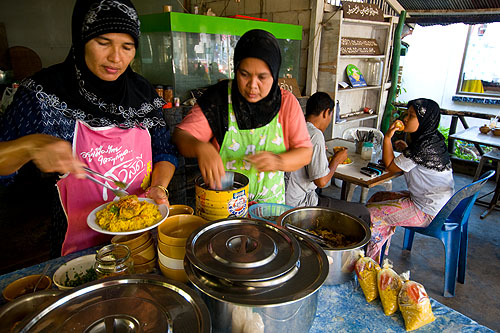
Fragrant with turmeric and other dried spices, it's a dish usually regarded as lunch elsewhere in Thailand.
Another popular breakfast is khanom jeen nam yaa pak tai, fresh rice noodles ladled with an equal parts creamy and spicy curry dressing:

You can cut the heat with some of the unusual toppings, which here ranged from slices of watermelon to pickled jackfruit, as well as some interesting local herbs.
And if you find this all a bit too much for breakfast, you can always go for the huge array of sweet-ish snacks on offer at just about any southern-style coffee shop:

Dhaka
Shooting photos in Dhaka, Bangladesh was the most fun I've had in a long time. There are few certifiable 'sights' in the city, but the hectic atmosphere and abundance of incredibly friendly people combined to make it a virtual game reserve for photographers. To commence a slideshow of 25 random images from the city, click on the image above -- use keyboard arrows or hold your mouse above the images to navigate through them.
Met ya hui
 or met ya ruang, or kayii or kayuu. Or met thai khrok or met hua khrok. Or perhaps even met mamuang himaphaan. These are all the different Thai dialect words for cashew nuts. The English word, cashew, is almost certainly a cognate of the Portuguese cajou, which apparently originates from the Tupi word acajú, and which is most likely also the source of kayuu, the term used on Phuket, the thought being that the Portuguese first introduced the fruit to Asia from its native Brazil.
or met ya ruang, or kayii or kayuu. Or met thai khrok or met hua khrok. Or perhaps even met mamuang himaphaan. These are all the different Thai dialect words for cashew nuts. The English word, cashew, is almost certainly a cognate of the Portuguese cajou, which apparently originates from the Tupi word acajú, and which is most likely also the source of kayuu, the term used on Phuket, the thought being that the Portuguese first introduced the fruit to Asia from its native Brazil.
Met ya hui and met ya ruang, however, are the terms used only on the island of Ko Yao Noi, in the Phang Nga Bay, not far from Phuket. As in much of the south, cashew trees are just about everywhere on this beautiful island, their yellow and red fruit emitting a sweet smell and making colourful stains on the roads:

Most of us have only ever eaten cashew nuts plain, but in the south, cashews are used in various local-style curries, and the fruits are sometimes consumed as a sweet snack. I've also recently seen a cashew-based bottled drink here in Bangkok.
To prepare cashews for consumption, the nuts are first collected, separated from their fruits and dried, as illustrated at the top of this post. The next step involves roasting the nuts:

This is done in large black woks with holes in the bottom to encourage the nuts to catch on fire, causing a toxic substance in the shell to dissipate. When the nuts are flaming, hissing and emitting a shocking amount of black smoke, they're dumped onto the ground to cool:

After being peeled, the nuts can be eaten at this point. But if the cashews are to be packaged and sold, they're typically roasted in ovens first:

They're then graded for quality (whole nuts without any shells demand higher prices), packaged and sold:

Phuchka
 Undoubtedly my favourite dish I encountered in Bangladesh was phuchka (known elsewhere as panipuri), tiny crispy poori-like breads filled with a delicious mixture of spiced beans, chunks of potato, diced shallots, chopped fresh chili and cilantro (illustrated above, at the top). The phuchka are spicy, fresh, sour, and are small enough to be consumed in one go. The beans used were most likely a type of chickpea, but actually reminded me of the tender gula ärtor Swedes traditionally eat in their ärtsoppa every Thursday.
Undoubtedly my favourite dish I encountered in Bangladesh was phuchka (known elsewhere as panipuri), tiny crispy poori-like breads filled with a delicious mixture of spiced beans, chunks of potato, diced shallots, chopped fresh chili and cilantro (illustrated above, at the top). The phuchka are spicy, fresh, sour, and are small enough to be consumed in one go. The beans used were most likely a type of chickpea, but actually reminded me of the tender gula ärtor Swedes traditionally eat in their ärtsoppa every Thursday.
A variation on the dish, consumed in Khulna, southern Bangladesh, did away with the act of stuffing altogether and simply served the crumbled bread over the bean mixture, which also had slices of hard-boiled egg:

I believe this version is called chatpati, which was also the name of the shop. Regardless, an essential part of this dish appears to be a sour tamarind-based, watery sauce/dip, which was served with both types.
A reunion
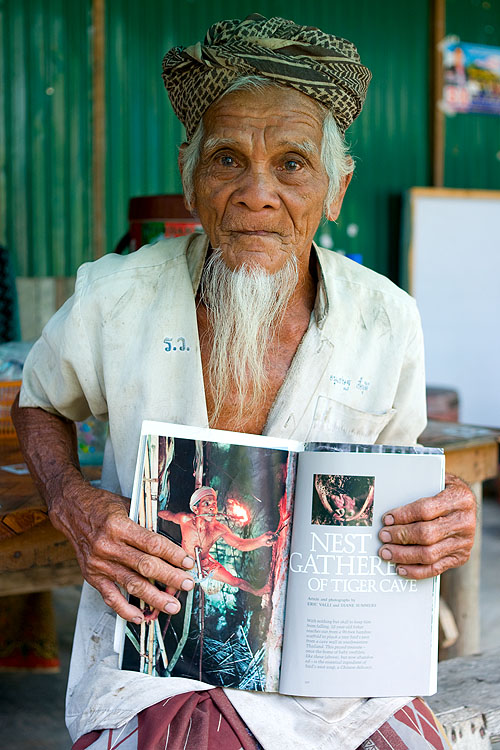 The first time I was on Ko Yao Noi was in 2007 when I was assisting French photographer Eric Valli for the book project, Thailand: 9 Days in the Kingdom. For his assignment, Eric had chosen to photograph the Muslim islanders who gather swallows' nests (a Chinese delicacy) in local caves, revisiting a topic he had documented in a film, book and National Geographic article in the late 1980s and early 1990s. During the nine days we worked mostly with the new generation of bird nest gatherers, but Eric did make a point of stopping by to say hello to Sahat, a now elderly gatherer who was the superstar of his previous work. Despite his age, Sahat was still as spry as ever, at one point proving to us that he could still climb by quickly scaling a vine hanging over our boat!
The first time I was on Ko Yao Noi was in 2007 when I was assisting French photographer Eric Valli for the book project, Thailand: 9 Days in the Kingdom. For his assignment, Eric had chosen to photograph the Muslim islanders who gather swallows' nests (a Chinese delicacy) in local caves, revisiting a topic he had documented in a film, book and National Geographic article in the late 1980s and early 1990s. During the nine days we worked mostly with the new generation of bird nest gatherers, but Eric did make a point of stopping by to say hello to Sahat, a now elderly gatherer who was the superstar of his previous work. Despite his age, Sahat was still as spry as ever, at one point proving to us that he could still climb by quickly scaling a vine hanging over our boat!
Two years later find myself on Ko Yao Noi again and decided to stop by to see how Sahat was doing. I could only vaguely remember the street he lived on, but somehow found him, amazingly wearing the same Thai schoolboy's shirt as last time! The image above shows him holding a copy of the National Geographic article that features him, an item he keeps along with Eric's book in a plastic bag. The pages of both are worn and falling out, the victims of many viewings, and he appears exceedingly proud of having been recognized for his amazing work.
As for me, despite being on a tropical island, I am, if you'll excuse my Swedish, jävligt upptagen at the moment, but will post some pics from Bangladesh when I get some time.
Bangladeshi sweets
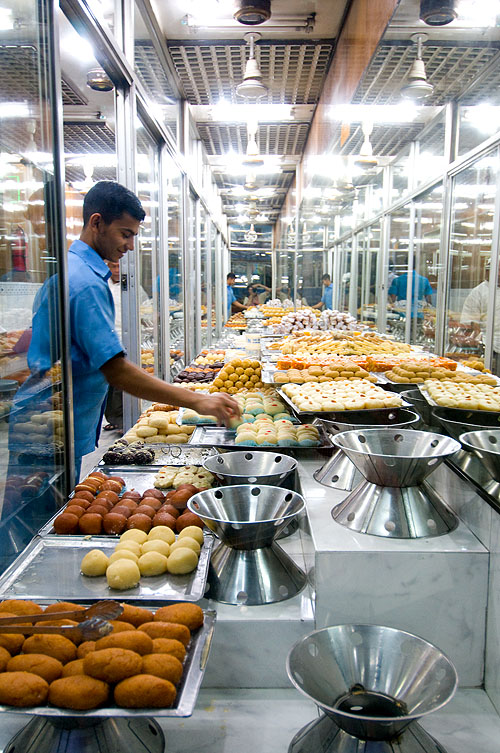 In general, food in Bangladesh wasn't much to write home about. There were a few interesting dishes, some of which I'll blog about soon, but most of our meals seemed to be endless but eerily similar variations on mutton and rice. The one area we were most impressed with was sweets. These ranged from syrupy-sweet golab jam, below:
In general, food in Bangladesh wasn't much to write home about. There were a few interesting dishes, some of which I'll blog about soon, but most of our meals seemed to be endless but eerily similar variations on mutton and rice. The one area we were most impressed with was sweets. These ranged from syrupy-sweet golab jam, below:

to milky shondesh (background, image below) and the slightly more savoury mishti (foreground):

After a great deal of 'research', I realized that my preferences lie somewhere between the above, and this dish, taken at the sweets shop pictured at the beginning of this post, combined my favourite Bangladeshi sweets:

tender (and not overpoweringly sweet) carrot borfi, slightly firm and cardamom-rich laddu, and an unidentified one, which was remarkably similar in taste and texture to what we call 'old fashioned' donuts in the US.
There were even some great sweet-ish snacks, including poori (deep-fried bread) and semolina halwa:

And although jilapi, strands of dough that are deep-fried before being soaked in syrup, certainly looked interesting:

the combination of oily and sweet was just a bit too much for me.
Bangladesh
 I've spent the last several days traveling and taking photos in Bangladesh. It's dirty, noisy, crowded and the food isn't much to speak of. But the people here are by leaps and bounds the friendliest, kindest folks I've ever come across anywhere, and in a bizarre way, despite the garbage, pollution and poverty, Bangladesh is probably the most photogenic place I've ever been. Will be posting some more images here, including a bit of food-related stuff on the other blog, as soon as possible.
I've spent the last several days traveling and taking photos in Bangladesh. It's dirty, noisy, crowded and the food isn't much to speak of. But the people here are by leaps and bounds the friendliest, kindest folks I've ever come across anywhere, and in a bizarre way, despite the garbage, pollution and poverty, Bangladesh is probably the most photogenic place I've ever been. Will be posting some more images here, including a bit of food-related stuff on the other blog, as soon as possible.
If you can't stand the heat,
 get out of the hot spring. Or to put it in my context, leave Mae Hong Son. This was done with a great deal of reluctance, but it was beginning to get intolerably hot and smoky, a profound change from the first two weeks of my stay when I had to wear a fleece jumper and thick socks until lunch. One sign of the impending hot season is the floating restaurants that go up on the Mae Nam Pai:
get out of the hot spring. Or to put it in my context, leave Mae Hong Son. This was done with a great deal of reluctance, but it was beginning to get intolerably hot and smoky, a profound change from the first two weeks of my stay when I had to wear a fleece jumper and thick socks until lunch. One sign of the impending hot season is the floating restaurants that go up on the Mae Nam Pai: And now I'm back home in hot, sweltering Bangkok, although yet again in transition: tomorrow I'm off to Bangladesh (!) for a week and after that, will be in Phuket for a few days. An almost perverse contrast in destinations, for sure. Depending on the Internet situation in Bangladesh, I'll try to do some blogging, but can't make any promises.And lastly, I've entered a contest/marketing ploy for a prize to embark on my photographic 'Dream Assignment'. My dream assignment? Collaborating with a talented writer to document Thailand's regional cuisines in the form of a website and/or book. Details can be seen here. And if you really care, PIC me while there, ensuring that I'll make it to the final round of 20.
And now I'm back home in hot, sweltering Bangkok, although yet again in transition: tomorrow I'm off to Bangladesh (!) for a week and after that, will be in Phuket for a few days. An almost perverse contrast in destinations, for sure. Depending on the Internet situation in Bangladesh, I'll try to do some blogging, but can't make any promises.And lastly, I've entered a contest/marketing ploy for a prize to embark on my photographic 'Dream Assignment'. My dream assignment? Collaborating with a talented writer to document Thailand's regional cuisines in the form of a website and/or book. Details can be seen here. And if you really care, PIC me while there, ensuring that I'll make it to the final round of 20.
Laap Khom
 I was hoping to blog about a community group in Pha Bong, 10km outside Mae Hong Son, that gets together every weekend to make a spice mixture for laap, but when I drove out there on Saturday they weren't able to get enough lemongrass (they need a lot of lemongrass) and had rescheduled for the next day. Unfortunately I was leaving Mae Hong Son then and did not get a chance to witness this...
I was hoping to blog about a community group in Pha Bong, 10km outside Mae Hong Son, that gets together every weekend to make a spice mixture for laap, but when I drove out there on Saturday they weren't able to get enough lemongrass (they need a lot of lemongrass) and had rescheduled for the next day. Unfortunately I was leaving Mae Hong Son then and did not get a chance to witness this...
Dejected but hungry, the next best choice was to head to Laap Khom, a restaurant in Mae Hong Son that uses the very spice mixture.
The owner of Laap Khom is the type of older Thai man who screams at you (in a friendly way, of course), then pats you on the back and makes you feel welcome. Despite owning a restaurant specialising in northern Thai dishes, he and his wife are originally from Isaan, and their daughter is the only local.
To make laap khua they simply take an order of raw laap, which apparently has been seasoned ahead of time, and fry it up in a small wok:

'Usually my mom does this,' explained the girl apologetically as she cooked. She needn't apologise as it's a decent dish -- not the most refined laap khua you're going to find in the north, but rich and tasty. The dish is served with a variety of fresh herbs, a couple of which are bitter, a slightly bitter dipping sauce made coarse with the addition of roasted rice powder, and of course, sticky rice.
Laap Khom 13/1 Th Siri Mongkol 053 613 719 Lunch & dinner
Laap mueang
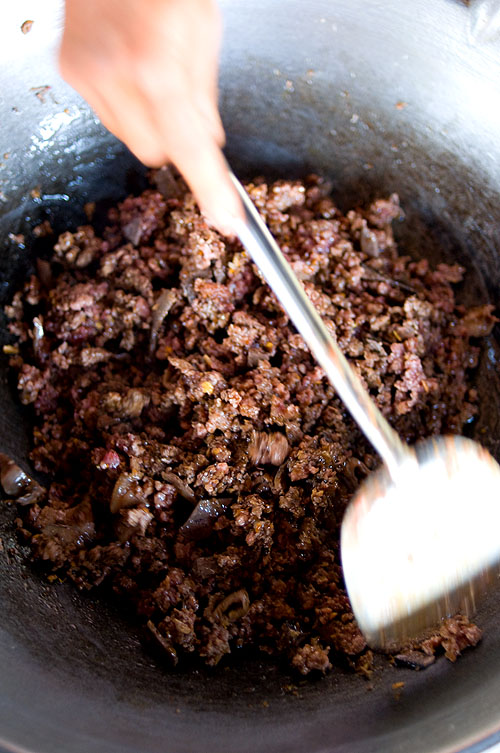 Fans of Thai food in the west are likely familiar with laap (or larb or laab), a minced meat ‘salad’ tart with lime juice and fragrant from the addition of khao khua, roasted and ground sticky rice. Fewer are likely familiar with the northern version of the dish of the same name, which contains neither khao khua nor lime juice, and instead gains its unique flavour from a mixture of dried spices specific to northern Thailand.
Fans of Thai food in the west are likely familiar with laap (or larb or laab), a minced meat ‘salad’ tart with lime juice and fragrant from the addition of khao khua, roasted and ground sticky rice. Fewer are likely familiar with the northern version of the dish of the same name, which contains neither khao khua nor lime juice, and instead gains its unique flavour from a mixture of dried spices specific to northern Thailand.
Laap mueang (mueang is a word used to describe anything northern) is one of my favourite Thai dishes. I've mentioned it a few times previously, but haven't really blogged about it in a general sense. So in this, the first of three blogs about the northern-style laap, I'm going to share general description of how it's made and the different varieties of it that exist. Because the spice mixture is such a crucial part of the dish, I'm hoping to follow this with a post about the delicious nam phrik laap (the spice mixture) made by a community group in Pha Bong, about 10km south of Mae Hong Son. And finally I'll follow that up with a recommendation for a decent laap restaurant here in Mae Hong Son.
If, after all this, you’re tempted to make laap khua, the northern-style ‘fried’ laap, I'd suggest combining the information provided in these blogs with this recipe provided the bloggers at EatingAsia, which appears to be a good approximation of the dish for those outside of northern Thailand without access to the more obscure ingredients.
I was able to watch Paa Add makes three types of laap while she was preparing food for her stall a couple days ago.
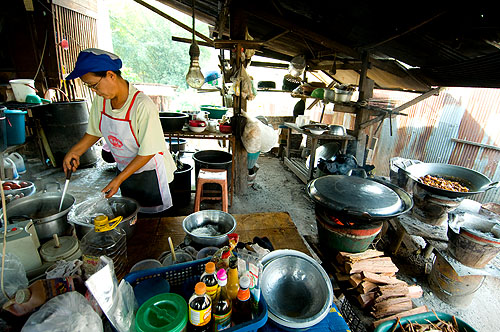
For all varieties of laap Paa Add begins with a variety of fresh pork and beef offal: liver, heart, tripe, intestine (both large and small), skin, fat and other unidentifiable (at least for me) bits. She boils them until tender and slices them thinly:
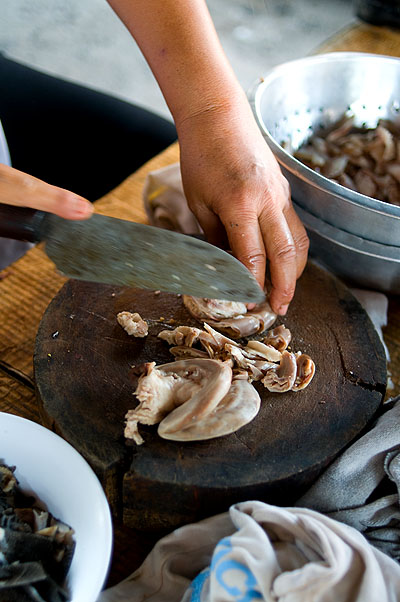
For the raw pork laap she takes a generous amount of fresh blood and liquefies it in a food processor. The impossibly red liquid is poured into a basin that already has some dried chili powder, salt, MSG, sugar and the laap spice mixture:
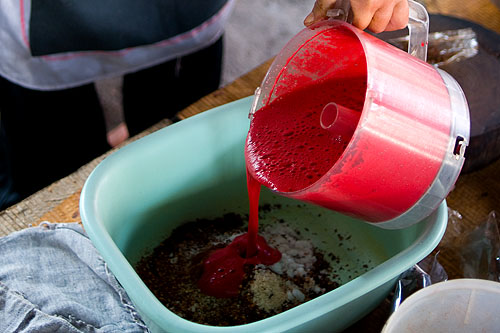
The ingredients are mixed with a spoon and raw minced pork is added. This is stirred again, checked for seasoning (after tasting the back of the spoon Paa Add added additional MSG, dried chili powder and some water), and the boiled pork offal is added. The laap is done at this point, and only requires a garnish of a mixture of minced coriander, sawtooth coriander (phak chee farang), green onions and mint, and of course, a fat basket of sticky rice to accompany it.
The process for making raw beef laap is nearly identical, except the ingredients, from the offal to the blood, are all beef-based, and a slightly bitter bile, known as phia, is added to the mixture:
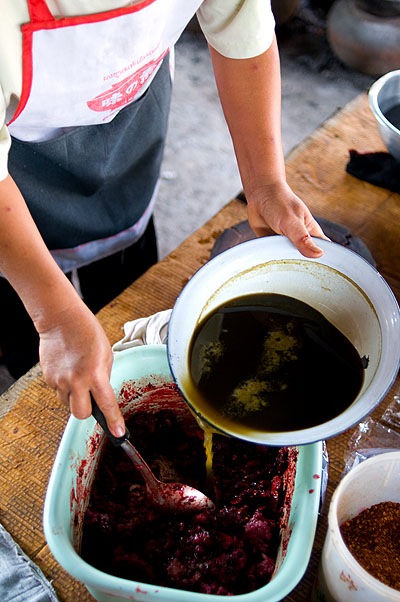
This type of laap is known in northern Thailand as laap khom, 'bitter' laap, because of the dominating flavour imparted by this ingredient.
The process to make make the more user-friendly laap khua, ‘fried’ pork laap, is initially at least, quite similar to the above. Paa Add combined some boiled pork offal, raw minced pork and a tiny amount of blood.
Into a large wok over hot coals she poured a very generous amount of cooking oil and added minced garlic, peels and all. She deep-fried the garlic until fragrant and ‘yellow’ in her words, before adding the pork mixture. This was followed by a generous amount of dried chili powder, MSG, salt, and the prepared laap spice mixture:
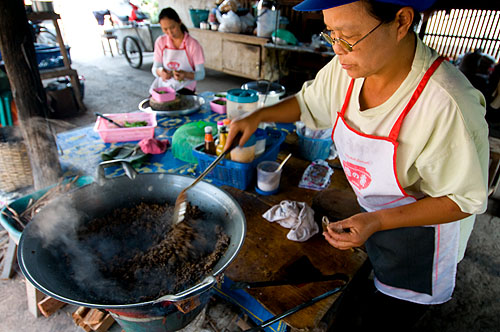
It took a good few minutes of cooking and stirring before the meat was thoroughly cooked and fragrant. She let me taste it at this point and the laap was intensely rich and spicy, and had the oily consistency associated with this version of the dish. Garnished and served with sticky rice and bitter herbs, it's among the most satisfying dishes in this part of the world.
How To Make: Khai oop
 Paa Add cooks and sells a variety northern Thai and Shan dishes at Kaat Yaaw, Mae Hong Son’s evening market. She can be a bit of a hard sell, but is an extremely talented cook, her dishes both well executed and perfectly seasoned (her local-style fern shoot salad is a culinary masterpiece), even if you’re not familiar with the cuisine. I’d been buying her delicious curries, stir-fries and salads since coming here, when one day I asked her if she’d mind if I stopped by to see how they were made. She immediately dropped what she was doing and stared at me for at least five seconds. ‘Are you going to open a restaurant abroad?’ she asked.
Paa Add cooks and sells a variety northern Thai and Shan dishes at Kaat Yaaw, Mae Hong Son’s evening market. She can be a bit of a hard sell, but is an extremely talented cook, her dishes both well executed and perfectly seasoned (her local-style fern shoot salad is a culinary masterpiece), even if you’re not familiar with the cuisine. I’d been buying her delicious curries, stir-fries and salads since coming here, when one day I asked her if she’d mind if I stopped by to see how they were made. She immediately dropped what she was doing and stared at me for at least five seconds. ‘Are you going to open a restaurant abroad?’ she asked.
Despite her initial skepticism, and with my promises that I wasn’t going to open a restaurant, she allowed me to come to her house and was a kind host and a patient teacher. She made several things that day, ranging from a delicious soup of grilled pork and phak waan, a local vegetable:

to three different types of laap, a northern Thai meat dish, that I plan to detail in a subsequent post. She usually makes a total of seven dishes to sell, including a few she does every day, including laap, moo phalo, and a sublime kaeng hang lay:

She prepares all these dishes by 1pm, then loads them on a cart to take to the market:

The dish I want to share first is khai oop, a dish emblematic of Mae Hong Son-style cooking, as well as a very simple dish to make, the ingredients for which are obtainable just about anywhere. Although Paa Add made enough to feed a dozen people, I’ve adapted the recipe to make a decent serving for two.
Khai Oop (Shan-Style Egg Curry)
Hard-boiled eggs, peeled 3 or 4 Shallots, sliced, 2 Garlic, small cloves, 20 Tomatoes, seeded and sliced, 2 Oil, 2 Tbsp Shrimp paste, 1 Tbsp Turmeric powder, 1 tsp Dried chili powder, 1 tsp, or to taste Salt, sugar, MSG, to taste
In a mortar and pestle or food processor, combine shallots, garlic and tomatoes. Blend thoroughly, set aside.
Heat oil in a wok over med-low heat. Add shrimp paste and turmeric, stirring to combine with oil. When fully incorporated and fragrant, add shallot mixture and chili powder (shown at the top of this post).

Allow to simmer and reduce, stirring constantly to avoid sticking. It is at this point where my recipe differs slightly from Paa Add’s. She used enough oil (more than enough, actually) so that the shallot mixture never really dried up or stuck to the wok. When I made the dish it quickly became dry, so I added water, a couple tablespoons at a time. I allowed the water to reduce and added more, repeating this process until the mixture gained a smooth, slightly oily consistency.
Season with salt, sugar and MSG as desired. Add eggs to mixture, and allow to heat up:

Serve khai oop with rice.














